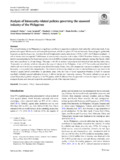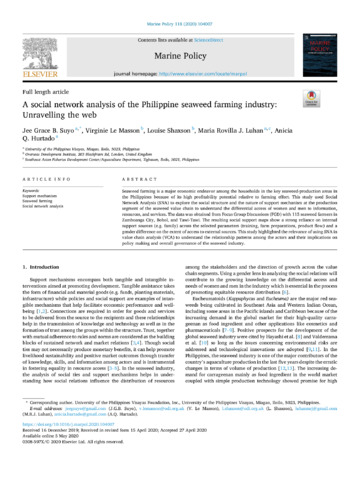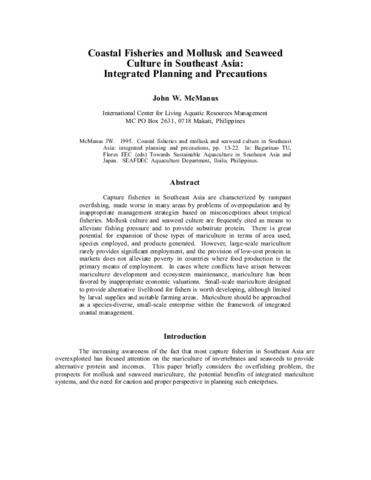Biosecurity policy and legislation for the global seaweed aquaculture industry
- Global styles
- MLA
- Vancouver
- Elsevier - Harvard
- APA
- Help

Download URL
link.springer.com日付
2020-08著者
Page views
1,653ASFA keyword
AGROVOC keyword
Metadata
アイテムの詳細レコードを表示するCited times in Scopus
110 readers on Mendeley
- Citations
- CrossRef - Citation Indexes: 3
- Policy Citation - Policy Citations: 3
- Scopus - Citation Indexes: 55
- Captures
- Mendeley - Readers: 110
- Mentions
- Blogs: 1
Share
抄録
Each year a significant proportion of global food production is lost to pests and diseases, with concerted efforts by government and industry focussed on application of effective biosecurity policies which attempt to minimise their emergence and spread. In aquaculture the volume of seaweeds produced is second only to farmed fish and red algal carrageenophytes currently represent approximately 42% of global production of all seaweeds. Despite this importance, expansion of the seaweed sector is increasingly limited by the high prevalence of recalcitrant diseases and epiphytic pests with potential to emerge and with the demonstrated propensity to spread, particularly in the absence of effective national and international biosecurity policies. Developing biosecurity policy and legislation to manage biosecurity risk in seaweed aquaculture is urgently required to limit these impacts. To understand current international biosecurity frameworks and their efficacy, existing legislative frameworks were analysed quantitatively for the content of biosecurity measures, applicability to the seaweed industry, and inclusion of risks posed by diseases, pests and non-native species. Deficiencies in existing frameworks included the following: inconsistent terminology for inclusion of cultivated seaweeds, unclear designation of implementation responsibility, insufficient evidence-based information and limited alignment of biosecurity hazards and risks. Given the global importance of the cultivation of various seaweeds in alleviating poverty in low and middle income countries, it is crucial that the relatively low-unit value of the industry (i.e. as compared with other aquatic animal sectors) should not conflate with a perceived low risk of disease or pest transfer, nor the subsequent economic and environmental impact that disease transfer may impact on receiving nations (well beyond their seaweed operations). Developing a clear basis for development of robust international biosecurity policies related to the trade in seaweeds arising from the global aquaculture industry, by first addressing the gaps highlighted in this study, will be crucial in limiting impacts of pests and diseases on this valuable industry and on natural capital in locations where seaweeds are farmed.
Keywords
Aquaculture Biosecurity Carrageenophyte Policy SeaweedSuggested Citation
Campbell, I., Kambey, C. S. B., Mateo, J. P., Rusekwa, S. B., Hurtado, A. Q., Msuya, F. E., Stentiford, G. D., & Cottier-Cook, E. J. (2020). Biosecurity policy and legislation for the global seaweed aquaculture industry. Journal of Applied Phycology , 32, 2133-2146. https://doi.org/10.1007/s10811-019-02010-5
Type
ArticleISSN
0921-8971; 1573-5176Collections
- Journal Articles [1247]
Except where otherwise noted, this item's license is described as http://creativecommons.org/licenses/by/4.0/
Related items
Showing items related by title, author, creator and subject.
-
Analysis of biosecurity-related policies governing the seaweed industry of the Philippines
Mateo, Jonalyn P.; Campbell, Iona; Cottier-Cook, Elizabeth J.; Luhan, Maria Rovilla J.; Ferriols, Victor Marco Emmanuel N.; Hurtado, Anicia Q. (Springer Verlag, 2020-03-10)The seaweed industry in the Philippines is a significant contributor to aquaculture production, both nationally and internationally. It out-produces the capture fisheries sector and most global producers, with the exception ...3434 Total citations21 Recent citations6.44 Field Citation Ration/a Relative Citation Ratio
-
A social network analysis of the Philippine seaweed farming industry: Unravelling the web
Suyo, Jee Grace B.; Le Masson, Virginie; Shaxson, Louise; Luhan, Maria Rovilla; Hurtado, Anicia Q. (Elsevier, 2020-08)Seaweed farming is a major economic endeavor among the households in the key seaweed-production areas in the Philippines because of its high profitability potential relative to farming effort. This study used Social Network ...2323 Total citations11 Recent citations9.22 Field Citation Ration/a Relative Citation Ratio
-
Coastal fisheries and mollusk and seaweed culture in Southeast Asia: Integrated planning and precautions
McManus, John W. (Aquaculture Department, Southeast Asian Fisheries Development Center, 1995)Capture fisheries in Southeast Asia are characterized by rampant overfishing, made worse in many areas by problems of overpopulation and by inappropriate management strategies based on misconceptions about tropical fisheries. ...






